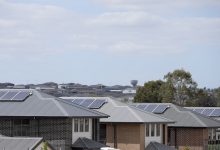Australia’s growing number of rooftop solar panels is becoming ubiquitous in Australia’s sprawling suburbia, but to the market operator it remains largely invisible. And that, it says, can be a problem.
AEMO chief Daniel Westerman has said, with distributed PV now the second-biggest source of electricity generation on the east-coast grid but this is creating new challenges in managing the grid.
And he is urging more households to sign up for what are known as “virtual power plants”, which make rooftop solar – and household batteries – visible to the grid, and enable them to have at least partial control.
Speaking at the Australian Energy Week conference in Melbourne on Tuesday, Westerman confirmed that large-scale renewables are not being built fast enough to meet the federal government’s 2030 targets, despite a massive pipeline of projects waiting in the winds.
At the other end of the scale, however, rooftop solar continues to thrive, with the roughly 15GW of installed capacity, equivalent to 25% of the grid’s generation capacity today, and with a five-fold increase over this level by 2050 forecast by AEMO.
At that level, says Westerman, “two-thirds of homes will have rooftop solar, and that power would meet nearly one-fifth of the east coast underlying demand.”
That’s nothing but a good thing for the climate and for households and businesses squeezed by rising power prices and other cost of living pressures, but it’s less than ideal for those tasked with managing energy system security.
“We’re attempting to stitch together a new system that is infinitely more complex, with a vast number of smaller generators, storage and firming technologies, and 3.5 million rooftop solar systems,” Westerman says.
“Huge amounts of rooftop solar can sometimes be a challenge because it is largely invisible and doesn’t yet respond to either market or operational signals.
“As you know, electricity supply and demand must be balanced at every point in time. An oversupply of generation, even from rooftop solar, would cause our electricity system to lose balance with dire consequences.
“On mild sunny days, the energy from our rooftops floods the grid, overwhelming most other forms of generation.”
Just how challenging it can be to manage this flood of generation was cast in stark relief late last year, when wild storms damaged the South Australian transmission network and caused the state to be “islanded” from the main grid.
In what Westerman now describes as a “postcard from the future,” the isolation of the South Australia grid for just over a week forced AEMO to introduce emergency measures to maintain grid stability, including taking action to switch off as many of the state’s rooftop solar installations as it could in the middle of the day.
The experience illustrated to the market operator that having a solar switch-off button at your disposal, to remotely stop rooftop PV from exporting to the grid is an important insurance policy in emergencies – but only as a last resort.
It also underscored the pressing need to find much cleverer and less heavy-handed ways to manage distributed energy resources that harness the benefits of cheap and abundant rooftop-generated solar while keeping the grid steady.
“The first is to agree a set of operating procedures to help manage a potential flood of solar generation from rooftop systems if it becomes a threat to system security,” says Westerman.
“A far more preferable approach, though, is for rooftop solar owners to become an active participant in our energy market, by joining together to form a virtual power plant, or VPP.”
As the AEMO chief notes, there are a number of these already operating around Australia, including in South Australia where Tesla has pooled together solar and Powerwall 2 batteries installed across more than 5,000 homes.
According to the Tesla team overseeing the SA VPP, customers in that state with solar and a Powerwall with no smart energy management applied can cut their electricity costs to around $70 a month. But if the software is engaged to operate as a VPP, then the cost turns into average monthly revenue of $61.
And the potential when you marry smart management software with other behind-the-meter resources and energy loads holds even more promise, both for consumers and the market operator.
“We hope to see these products being extended to a broader range of products including electric vehicle charging,” Westerman said on Tuesday.
“This will provide benefits to customers and the power system as demonstrated in the way VPPs can provide essential system services for the grid, like we’ve seen in Project Symphony in Western Australia, and Project Edge here in Victoria.”










